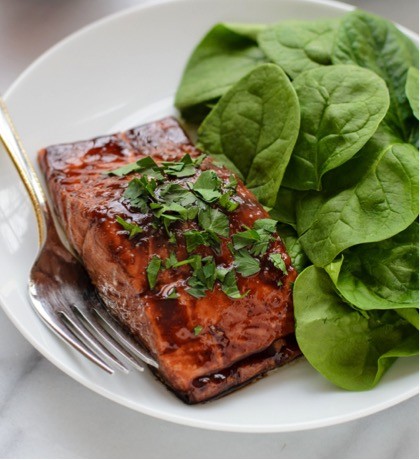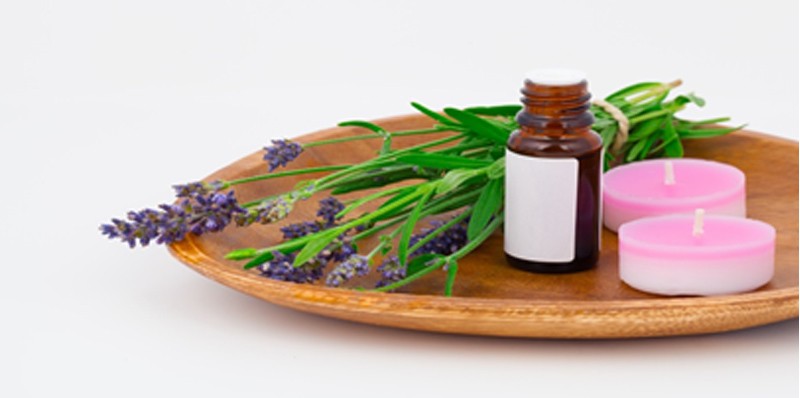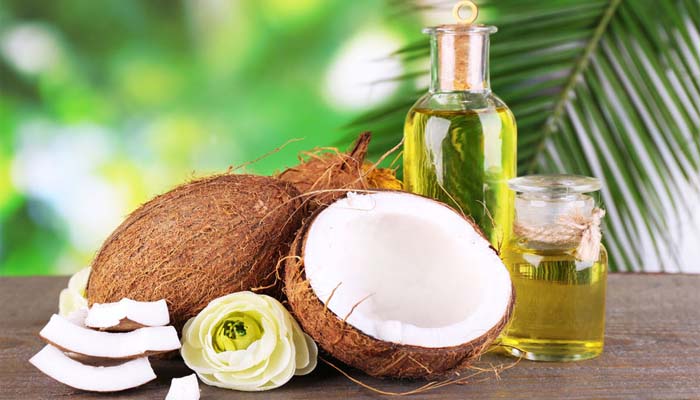How to Ease Depression with Probiotics

There is a lot of research linking an unhealthy gut to depression. Just as you have neurons in your brain, you also have neurons in your gut — including neurons that produce neurotransmitters like serotonin, which is also found in your brain and is linked to mood.
In fact, the greatest concentration of serotonin, which is involved in mood control, depression and aggression, is found in your intestines, not your brain. The reality is that 95 percent of it is manufactured in the gut. It’s quite possible that this might be one reason why antidepressants, which raise serotonin levels in your brain, are often ineffective in treating depression, whereas proper dietary changes often help.
A combination of nerves, hormones, bacteria, blood, and the organs of the digestive system handle the complex task of breaking down our food, absorbing nutrients, and expelling wastes—all the while keeping our immune system strong. Since digestion requires a considerate amount of the body’s energy, when it starts to struggle we can feel it in our emotions.
The brain sends signals to your gut, which is why stress and other emotions can contribute to gastrointestinal symptoms. The secret to improving your mood and brain health is in your gut, as unhealthy gut flora can impact your mental health, potentially leading to issues like anxiety, depression, autism and more. So the kind of microflora you have will in great part determine what kind of moods you have.
Limiting sugar, eating traditionally fermented foods, and adding probiotics are among the best ways to optimize your gut flora and subsequently support your brain health and normalize your mood. In fact, research has shown that adding probiotics an infant decrease anxiety, diminish perceptions of stress, and improve overall mental outlook.
Experimental studies have also shown that supplementing with probiotic bacteria can increase peripheral tryptophan levels. Tryptophan is a precursor to serotonin and dopamine (the other happy hormone), so increased tryptophan means increased serotonin and dopamine.
More and more studies are showing that as our diets have changed to include more chemical preservatives, the number of depression cases has also risen. We no longer eat the foods that help keep our guts in balance.
“Everyday emotional well-being may rely on messages from the brain below to the brain above.” –Michael Gershon, chairman of the Department of Anatomy and Cell Biology at New York–Presbyterian Hospital/Columbia University Medical Center, expert in neurogastroenterology.
TRYING OUT THE TRILOGY
•Kefir:
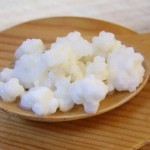 Try about ¼ cup the first day and see how you feel. You can try one of Donna Schwenk’s recipes. Drink it straight, or sweeten it with a little fruit, honey, or stevia for a sugar-free version.
Try about ¼ cup the first day and see how you feel. You can try one of Donna Schwenk’s recipes. Drink it straight, or sweeten it with a little fruit, honey, or stevia for a sugar-free version.
See how you feel, and if you’re doing great, you can have some more. If not, let your body adjust. Wait a day or two and try again.
•Kombucha:
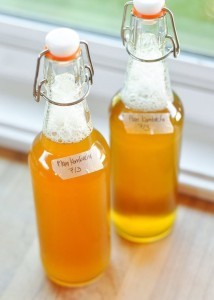
Kombucha is a fermented tea. It has been made as a health drink for thousands of years. It tastes like a sour/sweet sparkling cider. It aids your liver in detoxing and cleansing your body. It is specially good to at removing plastics and heavy metals from the body. It naturally gives you an energy boost.
Basic Kombucha –
Materials:
• Kombucha starter kit: To make kombucha, you need a kombucha SCOBY and 1 cup of already-made kombucha tea.
• Container: You will need a 1-gallon jar or lead-free crock.
• Linen or cloth napkin: This needs to be big enough to fit completely over the top of the jar or crock you’ve selected.
• Rubber band: Make sure this is big enough to go around the neck of the jug or crock you’ve selected. This will hold the napkin in place.
• Six 16-ounce glass bottles: Make sure these are good, sturdy bottles with clamp-down lids. You can repurpose beer bottles such as those from Grolsch, or you can buy new thick-glass bottles that are specifically designed for brewing. Bottles bought at craft stores aren’t as sturdy and may explode.
• Brew belt: This gadget is optional but highly recommended. It is basically a plug-in heater for your jar or crock. You wrap it around the container you’re using to brew your kombucha, and it keeps the tea at a consistent temperature between 75°F and 80°F
• 1 cup sugar (Sucanat, white sugar, or coconut sugar)
• 4 or 5 tea bags; you can use black or green tea, and organic is best
• 3 quarts filtered water (not distilled)
Makes 3 quarts
>>>Try about ¼ cup the first day and see how you feel. If you’re feeling great, you can have some more. If not, give your body time to adjust. Wait a day or two and try again.
Here’s another recipe shared by Sarah Wilson:
Fructose-free Kombucha –
1 litre pure, filtered water (note: most recipes advise not using tap as the chlorine can kill the SCOBY. I personally use tap and have not had issues.)
¼ cup rice malt syrup
2 organic black tea bags (many say non-organic tea just doesn’t work as well)
½ cup pre-made kombucha (from a previous batch or a commercial one in a bottle…see below)
1 SCOBY
You might need to leave it to ferment an extra day or two…it produces a slightly tarter result.
•Cultured vegetables:
Go slowly and eat only a spoonful per day for the first few days. Pay attention to how you feel. If you’re doing great, you can have some more. If not, let your body adjust. Wait a day or two and try again.
The Trilogy Recipe –
The Trilogy is made up of three magical, powerful, cultured foods: kefir, kombucha, and cultured vegetables.
These are not only delicious but also have the extraordinary ability to speak to the cells of your body, changing it from the inside out. These three foods have made me healthier and happier and they can do the same for you.
Ingredients
3 quarts filtered water (not distilled)
1 cup Sucanat, white sugar, or coconut sugar
4 or 5 tea bags (organic green tea is preferred, but black tea is good, too)
1 SCOBY (symbiotic colony of bacteria and yeast)
1 cup fermented kombucha tea
Step 1: Wash all utensils with hot, soapy water and rinse well.
Step 2: Bring the filtered water to a boil in a large pot over medium-high heat.
When the water has reached a rolling boil, add the sugar and continue to boil for 5 minutes.
Step 3: Turn off the heat and add the tea bags. Steep for 10 to 15 minutes; then remove the tea bags and let the tea cool to room temperature.
Step 4: Pour the cool tea into a 1-gallon container.
Step 5: Add the SCOBY, placing it so that the smooth, shiny surface faces up.
Step 6: Add the fermented kombucha tea.
Step 7: Place the cloth over the opening of the container and secure it with the rubber band. This keeps dust, mold, spores, and vinegar flies out of the fermenting tea.
Step 8: Let the covered container sit undisturbed in a well-ventilated and dark place at a temperature between 65° and 90°F for 6 to 15 days. To keep the temperature stable, a heating belt (brew belt) is highly recommended.
Step 9: To determine whether the tea is ready, do a taste test every couple of days, starting on the fourth day.
The tea should be tart, not sweet. However, it should not be overly sour or vinegary. If the tea is sweet, the sugar hasn’t been fully converted. If it tastes like sparkling apple cider, it is ready to drink, unless you want it more tart. If the vinegar taste is too prominent, it’s probably fermented a bit too long.
Step 10: When the tea is brewed to your taste, pour it into good, sturdy glass bottles with clamp-down lids. Once the bottles are filled, clamp the lids down and place the bottles in the refrigerator. The tea can be stored there for one year or longer.
We are supposed to be happy! But we cannot have the feeling of well-being, optimism and happiness if we don’t feed are bodies the right food.
Adapted from Donna Schwenkoriginal’s Article :
3 Probiotics that Can Ease Depression





![Day 20 – Becoming the Ideal Co-Creator [Oprah and Deepak Chopra Teachings]](https://www.forevernaturalwellness.com/wp-content/uploads/2017/05/discover-150x150.jpg)
